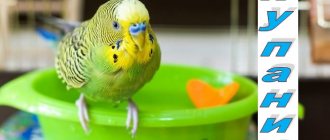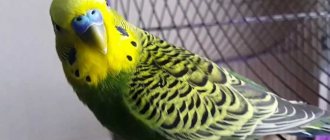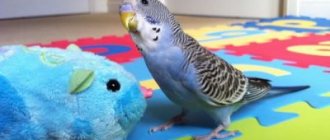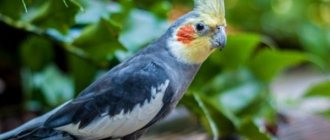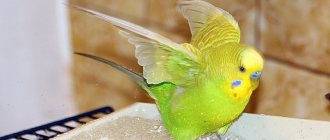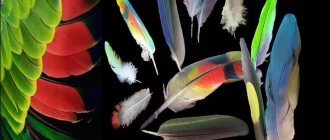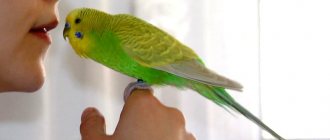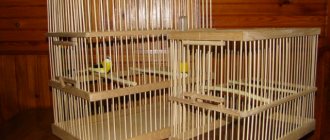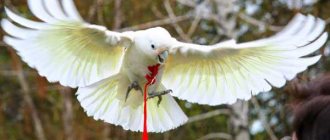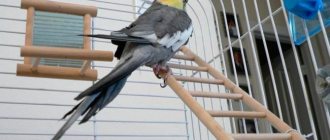A parrot's overall health and life expectancy depend on its nutrition. Therefore, the issue of feeding should be approached responsibly. From a very early age you need to choose the right diet. Feeding your pet food from the common table is prohibited! This can not only harm the parrot, but also be fatal.
Below in the article we will look at what food is most suitable for a parrot. The main diet includes: grain mixtures, cereals, fruit and vegetable components, greens and other options.
Grain food for parrots
The parrot must eat grain every day. This is his main food. Feeding once a day or adding little bits throughout the day doesn’t matter. The main thing is that it is a sufficient amount. A parrot should not be without grain food for more than a day.
In the veterinary pharmacy and pet store Gomeovet, there is a large selection of grain mixtures for different types of parrots. Their composition varies depending on the size of the parrot and its species, from budgies to large breeds. When buying food, pay attention to the integrity of the packaging and expiration date. Before you pour food into your parrot's feeder, check that there is no debris or other unnecessary impurities.
To prevent your pet from getting bored with grain, you can germinate it, thereby diversifying its diet. Sprouted grain has a large amount of vitamins and has a beneficial effect on the body. In order not to provoke the parrot's sexual behavior, you should wait until the grain has sprouted completely into grass.
In addition to sprouted grains, you can give nettle, dandelion, lettuce, green oat and wheat grass, and regular salad. These herbs can be easily grown on a windowsill.
The feeding of large breeds of parrots already includes additives in the form of seeds and nuts. You should not add these treats separately so as not to overfeed your pet. Rarely, you can use them for encouragement or treats.
Frequently asked questions about keeping a parrot
No less attention should be paid to choosing the house for the bird itself. And also where it is better to place it, what conditions to create for the parrot’s life.
How to choose and where to install the cage
There are several types of parrot cages. Each of them has its own advantages:
- Open top cage. The parrot will be able to leave its home at any time. Suitable for birds that know their home well and can return to it to eat or play.
- A closed cage of a standard type with a flat or rounded roof.
- Playground. It is already equipped with crossbars, swings, ladders - a very good option for a parrot who loves to play. He will definitely find something to his liking here.
The main criterion when choosing a cage is that the parrot’s home should be spacious. There are also a few other points to consider:
- The optimal distance between the rods is from 1 cm (for small birds) to 2.5 cm (for large ones). This is an important point, since the parrot can get hurt if it sticks its head between them.
- The best material for the cage is stainless steel. Such rods will withstand the parrot's beak. It is not advisable to buy a painted cage - very soon the paint will begin to peel off. This is both not aesthetically pleasing and dangerous for the pet who will eat it.
- The best shape is rectangular and wide. A tall parrot will have little room to fly and spread its wings. The round pet will feel disorientated.
- It’s good if the tray is retractable - this will make cleaning much easier.
The cage should always be in one place - parrots have a hard time moving, especially from one room to another. It is better for a pet to live in the room where the whole family most often gathers - these birds cannot stand prolonged loneliness.
The cage should be hung at eye level of the pet owner. You can’t place it on a windowsill due to temperature changes: it’s cool from the window, and hot from the radiators. Drafts are also contraindicated for parrots: they are heat-loving birds.
When the place of residence has been chosen, all that remains is to properly arrange the cage for the budgerigar and move the pet into it.
What is the lamp for?
It is advisable to hang a UV lamp above the parrot's cage, especially if the bird does not go outside. The lamp performs several functions:
- has a calming effect on the pet;
- helps survive periods of molting and hatching chicks;
- warms if the room is cool (about 18 °C and below);
- increases daylight hours: in summer – up to 12–14 hours, in winter – up to 10–12 hours.
Does a parrot need a mirror?
Parrots are social birds. Owners often hang a mirror in the cage to brighten up the pet's loneliness during hours when no one is home. The attitude towards such a decision is ambiguous. Often birds see their reflection in the mirror and actually decide that it is another bird. Sometimes this even helps develop the bird’s speaking talents.
But there are other cases. The bird decides that this is a rival and begins to hit the mirror with its beak. Then it’s better to get rid of the accessory. You need to choose an item made from a safe material - organic glass or a polished metal plate without chips or cracks.
Which filler is better to choose?
Another important detail is how to line the bottom of the cage. A lot depends on this: how comfortable and safe the parrot will be in the house, whether there will be a smell in the room, how often the area next to the cage will have to be cleaned.
There are several options here:
- Sand - river or from a pet store. The first one must be rinsed well and doused with boiling water or calcined. Parrots often use sand to play and bathe in it. It is a natural odor neutralizer. In addition, sand is needed to break down enzymes in the bird's stomach. But if parrots eat it in large quantities, you need to contact a veterinarian.
- Paper. Only pure white is suitable - printing ink can harm the health of your pet. But the consequences can be unpleasant in any case: parrots tend to eat paper, which often results in a clogged crop.
Some bird owners prefer to leave the tray empty, but this is not the best option.
Vegetables, fruits and berries
Having a pet, such as a cockatiel, the conditions for keeping and feeding it are not particularly different from other types of parrots, the main thing is to do everything according to the rules. Your pet should be accustomed to a routine from an early age.
The menu must include fruits and vegetables. It happens that birds are reluctant to eat these delicacies; the owner’s task is to competently approach the solution to this problem. You can cut them beautifully or select pieces of the appropriate size.
Healthy fruits:
- apricot;
- a pineapple;
- plum;
- pear;
- apple;
- cherry;
- watermelon;
- cranberry;
- kiwi;
- peach and others.
Before serving, it is better to peel the fruit and remove the seeds, if any. You can make preparations for the winter, and in winter defrost and treat the parrot.
Healthy vegetables:
- pumpkin;
- carrot;
- zucchini;
- cucumber;
- pepper;
- tomato;
- broccoli;
- green pea.
Most vegetables should be given fresh to retain all their beneficial properties; some can be pre-boiled.
You cannot give:
- mango;
- potato;
- persimmon;
- fruits in sugar;
- papaya.
Building material in nests
This is the first thing that comes to mind. The basic instinct is reproduction. You need a place where the eggs will hatch and the chicks will live for the first time.
There are several types of lovebirds:
- Madagascar Greyhead.
- Green-headed (collared).
- Spectacled.
- Taranta (black-winged).
- Orangehead.
- Rosy-cheeked.
- Masked.
Collecting material to create a nest
The masked lovebird has three subspecies:
- strawberryhead;
- Fisher's lovebird;
- black-cheeked.
Not all species build nests; some make do with a hollow in a tree. Some people are too lazy to look for a hollow; the bird makes its bedding right on the ground.
The nest is built by the female (gender discrimination...). In nature, the bird finds suitable twigs, blades of grass, leaves and drags them to the site of the future nest. Birds don’t have bags, so they have to insert “building materials” into the tail, into the feathers on the lower back. The hubby (future father of the family) more often interferes with the working female, hovering around, and some completely unreasonable ones try to pull the “decoration” out of the chosen one’s tail. Female spectacled lovebirds in nature and in captivity carry blades of grass or twigs in their beaks when building a nest.
Attracting a partner
Branch food for parrots
Feeding parrots must be correct. Their diet should contain not only grain mixtures, vegetables and fruits, but also twig food. Most owners don’t even know that twigs are necessary for proper nutrition. The twigs contain fiber and microelements, and they also help care for the beak.
What branches can you give:
- birch;
- hazel;
- elder;
- aspen;
- maple;
- Linden;
- Rowan;
- Apple tree.
They need to be collected away from roads and first doused with boiling water. Twigs can be given all year round. In winter, they should be placed in water to allow the buds to swell.
Attracting a female
During the mating season, male parrots try to attract the attention of females. This is done in different ways. A long, luxurious tail is cool. Therefore, parrot boys lengthen their short tail and decorate it with blades of grass and strips of clipped leaves; Paper, newspapers, books, wallpaper are used in the apartment. Particularly creative parrots decorate their tail feathers with toothpicks, twigs, and can insert a strip nibbled from a cabbage leaf into their tail. Branches from a broom are also suitable for decorating the tail.
Juices and water
Parrots must get water. Its amount depends on how much water the pet gets from fruits and vegetables and what the air temperature is in the room. You need to change the water daily, even if it seems to you that your pet hasn’t drunk it. In summer, you need to change it 2 times a day.
It is better not to give boiled, carbonated and tap water. Fill the drinker with filtered or bottled water. It is possible to add lemon juice, rosehip or chamomile decoction to the water.
Juices are considered no less beneficial for parrots. You can make it in a juicer or buy ready-made baby juices, the main thing is that they do not contain sugar. It is possible to dilute them with water. Keep an eye on the freshness of the juice, they can spoil very quickly, especially in summer.
Methods for solving the problem
Experienced breeders recommend weaning your feathered pet from a bad habit in the following ways:
- when the bird once again flies to its favorite place in order to gnaw the wallpaper, you should take a broom and, with careful movements, drive it away from this place, while pronouncing the word “impossible!” in a stern voice. You need to repeat the steps every time the bird comes to chew on the finish. After a while, one word will be enough for the bird to immediately fly away. At the same time, it is very important to make it clear to your ward that this is not a game, but a prohibition. Curious parrots can take all actions for fun and, every time during free walking, thus attract the attention of the owner;
- If the above method does not bring results, then it is recommended to use another radical method - place an onion or other object that emits an unpleasant odor next to your favorite place. The parrot will remember that the previous place began to smell bad and will stop flying there. But for this method, it is recommended to prepare a new activity for the beak in advance - build a platform from wooden branches that can lure the pet and wean it from eating wallpaper;
- If your parrot is chewing wallpaper, you can try to lure him into a play area with various objects. To do this, purchase a ready-made set or build it yourself. Various ladders and climbing bars are installed on the pallet. During play, the bird will actively use its beak, which will wean it from damaging decorative items;
- install in the cage special wooden ladders, stones, twigs intended for the beak point. If the parrot chews on objects in the cage, then it will not need to look for other things in order to sharpen its beak or just play.
Causes
Among the reasons why a parrot chews under its wing are the following factors:
- Lack of nutrients and vitamins in the body. This phenomenon may be due to calcium deficiency. In this case, the bird begins to peck its wings and inflict wounds on itself. It is recommended to maintain a balance in food and regularly include vitamin complexes in your diet. The best option to prevent nutritional deficiencies is to use a vitamin mixture;
- The presence of parasites on the parrot’s body, which cause discomfort and force it to constantly scratch and peck at the body. Among the frequent parasites actively living in the plumage and under the skin are mites and feather eaters;
- The parrot chews under its wing because it is bored. This family creates a mate for life, so if you lose your half for various reasons, the pet can become very bored and get sick. Quite often, when alone, feathers are plucked, wings are pecked until there is blood. In general, the behavior of the bird changes greatly and becomes depressed. This condition can also occur as a result of a change in owner. This is especially true for large species of the family that live for a long time with one person;
- Pet habit. Strange behavior can be a manifestation of character in certain situations. Perhaps the pecking is due to demands for attention.
Natural features
In their natural habitat, birds constantly explore the world around them, in search of food and favorable living conditions. And they can “feel” an object only with the help of their beak and tongue. But it is important to remember that in this case, attempts to chew the bars of the cage will be infrequent and the periodic addition of new, interesting, safe toys will solve this issue.
Read also: Neutral grip pull-up
The instincts are to grind down the beak, because it does not stop growing throughout the pet’s life. The parrot should always have freely available objects that help with this: pieces of wood or tree bark, pieces of limestone or sandstone. If the bird still prefers rods, then you need to take care of the safety of this material; stainless steel without a color coating is best. This will protect him from eating harmful substances. If the beak grows excessively, only veterinary specialists can help.
I want something tasty
Parrots need mineral supplements . The cage must contain chalk, sepia or shell rock, which is adored by all parrots. If they are not there, the budgie will begin to chew on the cage. Of course, there is nothing useful about steel rods. But paint can be very harmful.
If a budgerigar chews on the bars of a cage covered with galvanization, enamel, paint, or rust, urgently transfer it to another cage. The bird can swallow these pieces and become poisoned or develop an intestinal obstruction. The best cage for a budgie is made of stainless steel. When nothing is scraped off the rods, there is no interest in gnawing on it.
There is also such a problem as an ever- growing beak . If your pet does not have the opportunity to wear it down, health problems will inevitably arise. Parrots wear down their beaks by gnawing on various hard treats. Prepare branches of fruit trees, willow, and his beloved linden for your pet, and he will not need to chew on the cage.

